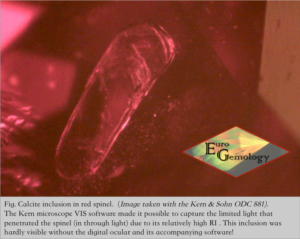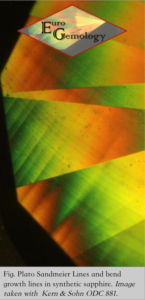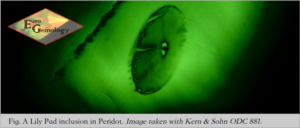With the technology of digital oculars – otherwise known as digital Eyepiece – being available on the market, it’s almost becoming indispensible to have one in your lab. It takes gemological microscopy to a whole new level, allowing you to live stream on a large screen, while digitally enhancing the strength of incoming light, colors, contrast etc…. Now you can sit back and relax during your research with hardly any strain on the eyes. Thanks to the optical zoom, you can now see things that you could hardly observe before, while capturing pictures or footage at the same time.
THE ODC 881 FROM KERN & SOHN IN PRACTICE
Advantage of Live Streaming
Microscopy is very crucial to gemology, enabling a gemologist to identify specific phenomena such as inclusions, treatments, growth structures etc…. Overall it is mainly used to separate the natural gemstones from its synthetic counterparts or artificial products used as imitations.
Researching through a microscope takes a lot of practice and experience. Initially it can slow down the progress of an upcoming gemologist. Instead of him/her focusing on inclusions, treatments and observing synthetic features he/she loses focus, due to struggling with the functions of a microscope and the orientation of light, let alone the manipulation of all possible filters. In most cases gemological educational centers use slides to educate subjects like gemstone inclusions and treatments. The downside here is that you can only see one phenomenon at a time. Here the digital ocular ODC 881 from Kern & Sohn comes really at work, allowing gemology teachers for their students to visualize these specific phenomena on a large screen, while explaining the manipulation of the microscope. In addition to this, it also allows the teacher to scroll through the gemstone and unfold all possible phenomena that can be seen in one single gemstone. You could compare this manner of working to performing ultrasound scan on a human body, but using light instead of sound waves.
The ODC 881 had been used on a gem fare during the determination of mounted gemstones, allowing everybody to see everything during the research procedure, creating a transparent atmosphere and increasing confidence to the owner of the gemstone or jewelry.
During the process of researching a gemstone with the microscope, there is a continuous lack of light when observing darker gemstones. This can also be the case in light colored gemstones at high zoom levels. When those dark gemstones get placed between crossed polarizer’s in immersion liquids, light will hardly pass through the “to be” observed material. This can make it, for example, almost impossible to find the optical axis in some cases. During tests it showed that the ODC 881 with the Kern microscope VIS software made it possible to see this optical phenomena in dark gemstones at large zoom levels. Overall the ODC 881 enables you to capture complicated optical phenomena such as bend growth structures in synthetic gemstones, Plato Sandmeier Lines etc….
 In other cases, researching gemstones with high refractive index without immersion liquids, causes the visualization of inclusions to be a real challenge. Due to the fact that light comes from the back, it gets reflected on the facets rather than the light breaking through the gemstone. The same usually happens with the on – light. For this reason the gemstone and inclusions are seen as “grayish black” when looking through the microscope, this happens due to the lack of light. Again, here the combination of the ODC 881 with accompanied software made it possible to see and capture inclusions in those high RI gemstones.
In other cases, researching gemstones with high refractive index without immersion liquids, causes the visualization of inclusions to be a real challenge. Due to the fact that light comes from the back, it gets reflected on the facets rather than the light breaking through the gemstone. The same usually happens with the on – light. For this reason the gemstone and inclusions are seen as “grayish black” when looking through the microscope, this happens due to the lack of light. Again, here the combination of the ODC 881 with accompanied software made it possible to see and capture inclusions in those high RI gemstones.
The extra features of the Kern Microscope Vis software are very useful to a gemologist, allowing him/her to measure critical angles, sizes of inclusions and so much more.
The ODC 881 allows the IDENTITY of the gemstone to be captured and eternalized, capturing the smallest details, like scratches on facets, specific inclusions, treatments along with their specific measurements. All these images can be added to the lab research report ensuring a client that the stone can never be swapped around for another gemstone that seems to look “identical”.





